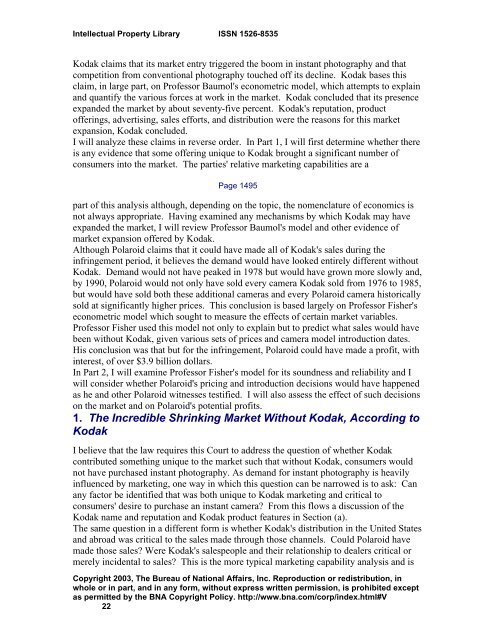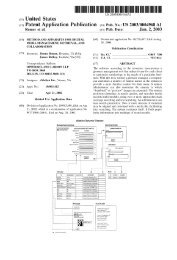Polaroid Corp. v. Eastman Kodak Co. - Oppedahl Patent Law Firm LLC
Polaroid Corp. v. Eastman Kodak Co. - Oppedahl Patent Law Firm LLC
Polaroid Corp. v. Eastman Kodak Co. - Oppedahl Patent Law Firm LLC
You also want an ePaper? Increase the reach of your titles
YUMPU automatically turns print PDFs into web optimized ePapers that Google loves.
Intellectual Property Library ISSN 1526-8535<br />
<strong>Kodak</strong> claims that its market entry triggered the boom in instant photography and that<br />
competition from conventional photography touched off its decline. <strong>Kodak</strong> bases this<br />
claim, in large part, on Professor Baumol's econometric model, which attempts to explain<br />
and quantify the various forces at work in the market. <strong>Kodak</strong> concluded that its presence<br />
expanded the market by about seventy-five percent. <strong>Kodak</strong>'s reputation, product<br />
offerings, advertising, sales efforts, and distribution were the reasons for this market<br />
expansion, <strong>Kodak</strong> concluded.<br />
I will analyze these claims in reverse order. In Part 1, I will first determine whether there<br />
is any evidence that some offering unique to <strong>Kodak</strong> brought a significant number of<br />
consumers into the market. The parties' relative marketing capabilities are a<br />
Page 1495<br />
part of this analysis although, depending on the topic, the nomenclature of economics is<br />
not always appropriate. Having examined any mechanisms by which <strong>Kodak</strong> may have<br />
expanded the market, I will review Professor Baumol's model and other evidence of<br />
market expansion offered by <strong>Kodak</strong>.<br />
Although <strong>Polaroid</strong> claims that it could have made all of <strong>Kodak</strong>'s sales during the<br />
infringement period, it believes the demand would have looked entirely different without<br />
<strong>Kodak</strong>. Demand would not have peaked in 1978 but would have grown more slowly and,<br />
by 1990, <strong>Polaroid</strong> would not only have sold every camera <strong>Kodak</strong> sold from 1976 to 1985,<br />
but would have sold both these additional cameras and every <strong>Polaroid</strong> camera historically<br />
sold at significantly higher prices. This conclusion is based largely on Professor Fisher's<br />
econometric model which sought to measure the effects of certain market variables.<br />
Professor Fisher used this model not only to explain but to predict what sales would have<br />
been without <strong>Kodak</strong>, given various sets of prices and camera model introduction dates.<br />
His conclusion was that but for the infringement, <strong>Polaroid</strong> could have made a profit, with<br />
interest, of over $3.9 billion dollars.<br />
In Part 2, I will examine Professor Fisher's model for its soundness and reliability and I<br />
will consider whether <strong>Polaroid</strong>'s pricing and introduction decisions would have happened<br />
as he and other <strong>Polaroid</strong> witnesses testified. I will also assess the effect of such decisions<br />
on the market and on <strong>Polaroid</strong>'s potential profits.<br />
1. The Incredible Shrinking Market Without <strong>Kodak</strong>, According to<br />
<strong>Kodak</strong><br />
I believe that the law requires this <strong>Co</strong>urt to address the question of whether <strong>Kodak</strong><br />
contributed something unique to the market such that without <strong>Kodak</strong>, consumers would<br />
not have purchased instant photography. As demand for instant photography is heavily<br />
influenced by marketing, one way in which this question can be narrowed is to ask: Can<br />
any factor be identified that was both unique to <strong>Kodak</strong> marketing and critical to<br />
consumers' desire to purchase an instant camera? From this flows a discussion of the<br />
<strong>Kodak</strong> name and reputation and <strong>Kodak</strong> product features in Section (a).<br />
The same question in a different form is whether <strong>Kodak</strong>'s distribution in the United States<br />
and abroad was critical to the sales made through those channels. <strong>Co</strong>uld <strong>Polaroid</strong> have<br />
made those sales? Were <strong>Kodak</strong>'s salespeople and their relationship to dealers critical or<br />
merely incidental to sales? This is the more typical marketing capability analysis and is<br />
<strong>Co</strong>pyright 2003, The Bureau of National Affairs, Inc. Reproduction or redistribution, in<br />
whole or in part, and in any form, without express written permission, is prohibited except<br />
as permitted by the BNA <strong>Co</strong>pyright Policy. http://www.bna.com/corp/index.html#V<br />
22





